Urgent Response Health & Safety Information
1. Exposure To Radio Frequency (RF) Signals Certification Information
Lively devices are radio transmitters and receivers. They are designed and manufactured to comply with the exposure limits for radio frequency (RF) energy set by the Federal Communications Commission (FCC) of the U.S. government. These limits are part of comprehensive guidelines and establish permitted levels of RF energy for the general population.
These FCC exposure limits are derived primarily from the recommendations of two expert organizations, the National Council on Radiation Protection and Measurement (NCRP) and the Institute of Electrical and Electronics Engineers (IEEE). In both cases, the recommendations were developed by scientific and engineering experts drawn from industry, government and academia after extensive reviews of the scientific literature related to the biological effects of RF energy.
The exposure limit set by the FCC for wireless devices employs a unit of measurement known as the Specific Absorption Rate (SAR). The SAR is a measure of the rate of absorption of RF energy by the human body expressed in units of watts per kilogram (W/kg). The FCC requires wireless devices to comply with a safety limit of 1.6 watts per kilogram (1.6 W/kg).
Although the SAR is determined at the highest certified power level, the actual SAR level of the device while operating can be well below the maximum value. This is because the device is designed to operate at multiple power levels to use as little power as possible to reach the network. In general, the closer you are to a wireless base station antenna, the lower the power output.
Before a new device is available for sale to the public, it must be tested and certified by the FCC to ensure that it does not exceed the exposure limit established by the FCC. Tests for each device are performed in positions and locations (e.g., at the ear and worn on the body) as required by the FCC. All Lively devices comply with SAR for general population/uncontrolled exposure limits in ANSI/IEEE C95.1-1992 and have been tested in accordance with the measurement methods and procedures specified in IEEE 1528.
While there may be differences between the SAR levels of various devices and at various positions, all Lively™ devices meet the government requirement for RF exposure.
The following paragraph applies to the Lively Mobile Plus:
For body-worn operation, Lively Mobile Plus devices meet FCC RF exposure guidelines provided that they are used with a non-metallic accessory with the device at least 5 mm from the body. Use of other accessories may not ensure compliance with FCC RF exposure guidelines.
SAR information on Lively devices can be viewed online at www.fcc.gov/oet/ea . To find information that pertains to a particular model device, this site uses the device FCC ID number which is usually printed somewhere on the case of the device or in the packaging. Once you have the FCC ID number for a particular device, follow the instructions on the website and it should provide values for typical or maximum SAR for a particular device.
Additional product specific SAR information can also be obtained at www.fcc.gov/consumers/guides/specific-absorption-rate-sar-cell-phones-what-it-means-you .
2. Consumer Information On Wireless Devices
The U.S. Food and Drug Administration (FDA) maintains a web page devoted to radiation-emitting products and RF exposure, including from mobile devices. It provides a wealth of information and frequently asked questions. You can find it here:
https://www.fda.gov/radiation-emitting-products/home-business-and-entertainment-products/cell-phones
Additional information on the safety of RF exposures from various sources can be obtained from the following organizations
FCC RF Safety Program: www.fcc.gov/oet/rfsafety
Environmental Protection Agency (EPA): www.epa.gov/radiation
Occupational Safety and Health Administration’s (OSHA): www.osha.gov/SLTC/radiofrequencyradiation
National Institute for Occupational Safety and Health (NIOSH): www.cdc.gov/niosh
World Health Organization (WHO): www.who.int/peh-emf
International Commission on Non–Ionizing Radiation Protection: www.icnirp.de
National Radiation Protection Board (UK): www.hpa.org.uk/radiation
3. Road Safety
Your wireless device gives you the powerful ability to communicate by voice, almost anywhere, anytime. But an important responsibility accompanies the benefits of wireless devices, one that every user must uphold. When driving a car, driving is your first responsibility. When using your wireless device behind the wheel of a car, practice good common sense and remember the following tips:
Become familiar with your state’s laws on the use of a wireless phone in a vehicle, and follow them, especially if they are more restrictive than the tips described below.
Get to know your wireless device and its features so you can place your call without taking your attention off the road.
Position your wireless device within easy reach. Be able to access your wireless device without removing your eyes from the road. If you get an incoming call at an inconvenient time, let it ring until you can safely answer.
Let the person you are speaking with know you are driving; if necessary, suspend the call in heavy traffic or hazardous weather conditions. Rain, sleet, snow, ice and even heavy traffic can be hazardous.
Do not take notes or look up device numbers while driving.
Place calls when you are not moving.
Do not engage in stressful or emotional conversations that may be distracting.
Use your wireless device to call for help. Contact 9-1-1 in the case of fire, traffic accident or medical emergencies.
Use your wireless device to help others in emergencies. If you see an auto accident, crime in progress or other serious emergency where lives are in danger, move to a safe location and then contact 9-1-1, as you would want others to do for you.
If you see a broken–down vehicle posing no serious hazard, a broken traffic signal, a minor traffic accident where no one appears injured, or a vehicle you know to be stolen, move to a safe location and then call Lively Urgent Response.
When you’re a passenger, educate others about the dangers of distracted driving.
Remember that an air bag inflates with great force. Do not place objects, including both installed or portable wireless equipment in the area over the air bag or in the air bag deployment area. If wireless equipment is improperly installed and the air bag inflates, serious injury could result.
“The wireless industry reminds you to use your Lively device safely when driving.”
4. Operating Environment
Remember to follow any special regulations in any area and always switch your Lively device off whenever it is forbidden to use it or when it may cause interference or danger. When on an aircraft, switch your Lively device OFF when instructed to do so. As with other mobile radio transmitting equipment, users are advised that for the satisfactory operation of the equipment and for the safety of personnel, it is recommended that the equipment should only be used in the normal operating position.
5. Using Your Lively device Near Other Electronic Devices
Most modern electronic equipment is shielded from RF signals. However, certain electronic equipment may not be shielded against the RF signals from your wireless device.
Implantable Medical Devices
A minimum separation of six (6) inches should be maintained between a handheld wireless device and an implantable medical device, such as a pacemaker or implantable cardioverter defibrillator, to avoid potential interference with the device.
Persons who have implanted medical devices:
Should ALWAYS keep the wireless more than six (6) inches from their implantable medical wireless when the device is turned ON.
Should not carry the device in a breast pocket.
Should use the ear opposite the implantable medical device to minimize the potential for interference.
Should turn the device OFF immediately if there is any reason to suspect that interference is taking place.
Should read and follow the directions from the manufacturer of your implantable medical device. If you have any questions about using your wireless device with any health care device, consult your health care provider.
For more information visit: www.fcc.gov/oet/rfsafety .
Other Medical Devices
If you use any other personal medical devices, consult the manufacturer of your device to determine if it is adequately shielded from external RF energy. Your physician may be able to assist you in obtaining this information. Switch your Lively device OFF in health care facilities when any regulations posted in these areas instruct you to do so. Hospitals or health care facilities may be using equipment that could be sensitive to external RF energy.
Vehicles
RF signals may affect improperly installed or inadequately shielded electronic systems in motor vehicles. Check with the manufacturer or its representative regarding your vehicle. You should also consult the manufacturer of any equipment that has been added to your vehicle.
Posted Medical facilities
Switch your Lively device OFF in health care facilities where regulations require, or any medical facility where posted notices instruct you to do so.
6. Potentially Explosive Environments
Switch your Lively device OFF when in any area with a potentially explosive atmosphere and obey all signs and instructions. Sparks in such areas could cause an explosion or fire resulting in bodily injury or even death.
Users are advised to switch the device OFF while at a refueling point (service station). Users are reminded of the need to observe restrictions on the use of radio equipment in fuel depots (fuel storage and distribution areas), chemical plants or where blasting operations are in progress.
Areas with a potentially explosive atmosphere are often but not always clearly marked. They include below deck on boats, chemical transfer or storage facilities, vehicles using liquefied petroleum gas (such as propane or butane), areas where the air contains chemicals or particles (such as grain, dust or metal powders) and any other area where you would normally be advised to turn OFF your vehicle engine.
Vehicles using liquefied petroleum gas (such as propane or butane) must comply with the National Fire Protection Standard (NFPA–58). For a copy of this standard, contact: National Fire Protection Association, Attn: Publication Sales Division, One Batterymarch Park, Quincy, MA 02169-7471
7. Emergency Calls
The Lively device, like any wireless device, operates using radio signals, wireless and landline networks as well as user–programmed functions, which cannot guarantee connection in all conditions. Therefore, you should never rely solely on any wireless device for essential communications (medical emergencies, for example).
Remember, to make or receive any calls, the device must be switched on and in a service area with adequate signal strength. Emergency calls may not be possible on all wireless device networks or when certain network services and/or device features are in use. Check with local service providers.
To make an emergency call:
If your Lively device is not on, turn it on.
Dial 9-1-1 and initiate the call. If certain features are in use (call barring, for example), you may first need to deactivate those features before you can make an emergency call. When making an emergency call, remember to give all the necessary information as accurately as possible. Remember that your Lively device may be the only means of communication at the scene of an accident. Do not cut off the call until given permission to do so.
8. FCC Notice And Cautions
FCC Notice
The device may cause interference with your TV or radio if used in close proximity to receiving equipment. The FCC can require you to stop using the device if such interference cannot be eliminated.
Cautions
Any changes or modifications to your Lively device not expressly approved in this document could void your warranty for this equipment and void your authority to operate this equipment.
9. Other Important Safety Information
Only qualified personnel should service the device or install the device in a vehicle. Faulty vehicle installation, or faulty service by third parties may be dangerous and may invalidate your device warranty.
Check regularly that all wireless device equipment in your vehicle is mounted and operating properly.
Do not store or carry flammable liquids, gases or explosive materials in the same compartment as the device, its parts or accessories.
Your Lively device is not a toy. Children should not be allowed to play with it because they could hurt themselves and others, damage the device or make calls that could increase your device bill.
Failure to observe these instructions may lead to the suspension or denial of service to the offender or legal action, or both.
10. Product Performance
Getting The Most Out Of Your Signal Reception The quality of each call you make or receive depends on the signal strength in your area. If you’re inside a building, moving to a window may give you better reception.
Understanding How Your Lively Device Works Your Lively device is basically a radio transmitter and receiver. When it’s turned on, it receives and transmits RF signals. When you use your Lively device, the system handling your call controls the power level. This power can range from 0.006 watts to 0.2 watts in digital mode.
Maintaining Your Lively device’s Peak Performance There are several simple guidelines to operating your Lively device properly and maintaining safe, satisfactory service.
Speak directly into the device’s microphone.
Avoid getting your Lively device and accessories wet. If your Lively device does get wet, immediately turn the power off. If it is inoperable, call our Customer Service.
For the best care of your Lively device, only authorized personnel should service your Lively device and accessories.
11. Battery Standby And Talk Time
Standby and talk times will vary depending on device usage patterns and conditions. Battery power consumption depends on factors such as network configuration, signal strength, operating temperature, features selected, frequency of calls and voice, data and other application usage patterns.
12. Battery Precautions
Although your Lively device is quite sturdy, it is a complex piece of equipment and can be broken. Do not drop, knock, crush, puncture, or shake the device. Rough handling or dropping on a hard surface can break internal circuit boards or damage the battery.
Do not put the device in an oven, a microwave oven, or on a stove or a radiator, as the device may explode.
Do not leave or store the device in hot or cold places, such as in a car in summer or winter conditions, in dusty or dirty areas, or near cooking surfaces, cooking appliances, irons, or radiators, as you will reduce the capacity and lifetime of the battery. Always try to keep the device at room temperature. A device with a hot or cold battery may temporarily not work, even when the battery is fully charged, and may require cooling or warming first. Lithium-ion batteries are particularly affected by temperatures below 0 °C (32 °F).
Never use a charger that is damaged in any way.
If you use the device near the network’s base station, it uses less power; talk and standby time are greatly affected by the signal strength on the cellular network and the parameters set by the network operator.
Battery charging time depends on the remaining battery charge and the type of battery and charger used. The battery can be charged and discharged hundreds of times, but it will gradually wear out.
Do not leave the device connected to a charger for more than a week, since overcharging may shorten its life.
If left unused, a fully charged battery will discharge itself over time.
When a charger is not in use, disconnect it from the power source.
Use only Lively-approved chargers. Use of incompatible device chargers or other accessories may void your device warranty. Some web sites and second–hand dealers, not associated with reputable manufacturers and carriers, might be selling incompatible or even counterfeit chargers. If unsure about whether a charger is compatible, contact the manufacturer of the charger.
Misuse or use of incompatible charging devices could result in damage to the equipment and a possible risk of fire, explosion, leakage or other serious hazards.
13. Care And Maintenance
Your Lively device is a product of superior design and craftsmanship and should be treated with care. The suggestions below will help you fulfill any warranty obligations and allow you to enjoy this product for many years.
Do not use the device with a wet hand. Doing so may cause an electric shock to you or damage to the device.
Do not use harsh chemicals, cleaning solvents or strong detergents to clean the device. Wipe it with a soft cloth slightly dampened in a mild soap–and–water solution.
Do not paint the device. Paint can clog the device’s moving parts and prevent proper operation.
If the device, charger, or any accessory is not working properly, arrange for service by calling our Customer Service.
Here’s more from Lively.
swipe for more
scroll or use your arrow keys for more
scroll for more
use your arrow keys for more


